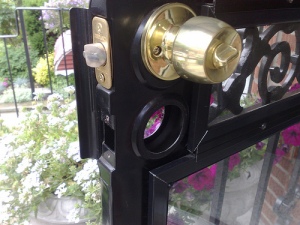Guest post by Naomi Broderick

Image Source
In many ways, the door is the most significant part of a home. It can carry heavy symbolic and emotional meanings for some, and if often used to that effect in films and literature. For many, doors are an important aesthetic decision; they come in a wide variety of sizes, styles, and colors. But for those with a mind for emergency preparedness, the most important feature is also the most obvious – and that is keeping unwanted elements out while allowing access to the household. Here are a few ways by which preppers can improve the functionality of their doors, depending on whatever emergency threatens their home.
How much damage can your door take?
One of the most unpredictable and common events that can risk the well-being of a homeowner is a home invasion. While home security equipment, appropriate fencing, and reinforced windows can all be excellent components in boosting a home’s ability in resisting home invasion, the truth is that no element is more crucial than the durability of one’s door. The fact is that a great majority of trespasses begin with a door – occasionally by a lock-pick, sometimes from a lock-bump, but most frequently due to a swift kick or shove.
There’s an expression that a chain is only as strong as its weakest link, and this principle applies very well in considering your doors. While pick resistant locks can be a worthwhile investment, a door which cannot withstand a few blows is nothing less than a hazard to your home security. While solid steel doors may be good for this purpose, they’re often neither appealing nor cost-effective. Instead, consider a few simple modifications that you can include to make your doors stand strong.
A door jamb reinforcement plate can make a huge difference on how well your door resists damage, and this is a popular, cost-effective choice. In addition, chain-anchored screw locks can supplement your reinforcement. When you can expect a great deal of damage to your door, either due to a hurricane warning or knowledge that a home invader is on the way, using a small wedge to support the knob’s corner can make busting through your entrance significantly more difficult.
What is the quality of your locks?
Once your door is sufficiently reinforced to handle brute force, the next way to make sure that your doors are criminal-proof is to install enhanced locks, deadbolts, or even biometric locks (a surprisingly affordable option in this day and age.) Choosing bump-proof models, while potentially expensive, is an essential decision, especially considering that the special “bump keys” made specifically for the purpose of exploiting the vulnerabilities in traditional locks are widely available online through various retailers.
It’s never a wise decision to have doors with windows installed in your primary entrances, since criminals all too frequently shatter these windows to deactivate your locks. Installing a shelf below windows prohibiting access to your lock can be a makeshift solution, but the best option if cost isn’t an issue is to replace the door entirely. Cover any windows on your doors with window film if replacement isn’t an option. If windows are near your door and aren’t reinforced, consider placing furniture or room dividers in such a manner as to avoid letting criminals reach in to disarm any locks you have in place.
How well does it seal your environment?
While keeping out unwanted visitors is a great accomplishment for any well-reinforced door, keeping out the elements is also a desirable goal you can achieve with the right door modifications. This can be particularly important for grid-down scenarios in which your home remains without indoor climate control options, such as what occurs frequently during particularly harsh winters in colder climes.
Weatherizing your doors with weather-stripping should be something already in place no matter what conditions are outside, considering that it can save a great deal of energy from being wasted. Check your hinge screws to ensure that they’re maintained and tight, since they can become loose over regular usage with time. In addition, padding crevices at the seals of your windows and doors with blanketing or thick insulating sheets can help tremendously in keeping the heat naturally generated from your household’s bodies inside.
With these tips, preppers should be able to enhance the functionality of their doors during the times that they need the shelter it provides most. What other ways would you recommend in sealing and protecting a door from home invasion and the elements?
Author’s bio: Naomi Broderick is a stay-at-home mother from the rural Northwest who advocates for emergency preparedness. She currently writes with Protect Your Home, a home security service provider who deals ADT in Phoenix, Arizona.
Related articles
- Security Advice to My Daughter: Essential Pillars of Preparedness Series (survivalsherpa.wordpress.com)







